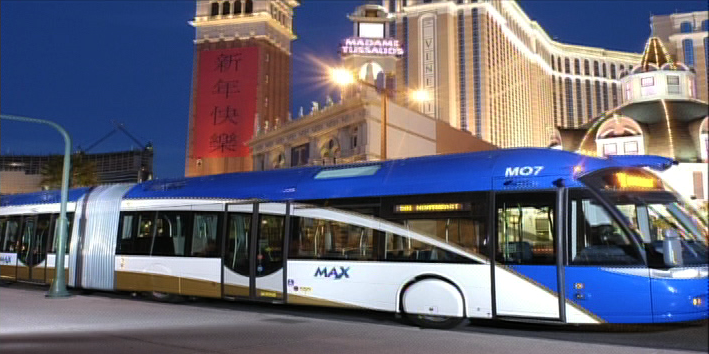
Planners Propose Countywide Transit Network
On Thursday, November 8, transportation planners hoping to increase the appeal of transit for people living in Montgomery County’s centers – Silver Spring, Bethesda, White Flint, and Germantown – will present the Planning Board with preliminary recommendations for a countywide transit network.
The recommended transit corridors will accommodate bus rapid transit (BRT) with all-day service, 10- or 15-minute wait times, stations or stops every half-mile or mile, and high-quality vehicles that resemble streetcars rather than traditional buses. Planners recommend rapid transit service primarily in existing lanes that would be repurposed to serve transit. Locating BRT within existing pavement wherever possible would help avoid large capital costs and environmental impacts.
Transportation modeling estimated the number of potential riders and found, unsurprisingly, that densely populated activity and employment centers will generate a greater number of transit riders. The recommendations focus on service in those areas, where high-quality transit mixed with growing mixed-use centers will make the best use of available road space.
While it makes sense to put transit where people are and want to be, planners explain that fitting it into existing roads will be a challenge. They recommend converting travel lanes to bus service
on roads within first-ring communities inside and near the Beltway, as well as along the I-270 Corridor, where the forecast transit ridership is highest.
In their analysis, planners used a threshold for dedicated lanes of 1,000 passengers per hour in the peak direction in the peak period. In areas with lower levels of forecast transit demand, they recommend that buses generally operate in mixed traffic but prioritized at traffic lights.
Their studies showed:
- Highest forecast ridership (49,000 riders a day) along MD355 between Friendship Heights and Rockville. Dedicated lanes or a dedicated busway would provide frequent all-day service in that corridor.
- To accommodate high ridership on more commuter-focused corridors they recommend a mix of options. For example, along US29, with 17,000 forecast daily riders they recommend a mix of dedicated lanes (south of Lockwood Drive), mixed traffic (on Lockwood Drive and Stewart Lane in the area of the White Oak Transit Center), and a median busway north of Stewart Lane.
Planners ran the transportation model both with and without a test of lane-repurposing on segments of four corridors: MD355/Rockville Pike, MD97/Georgia Avenue, US29/Colesville Road, and MD650/New Hampshire Avenue to determine the relative impacts on transit ridership, vehicle miles traveled (VMT), and vehicle hours traveled (VHT) in the year 2040. Results varied by area but were generally favorable, and the benefits were greatest in the down-county area; in Silver Spring alone, VMT would be reduced by 6 percent.
While a forecast of sufficient ridership is needed to justify transit, planners also point out the need a pedestrian-friendly environment to attract that ridership. They emphasize that safe, handicapped-accessible pedestrian facilities, attractive shelters and landscaping, and bike access to stations are needed to make a top-tier, well-functioning system. They hope to refine standards for those amenities in the next phase of work.
WHO:
Montgomery County Planning Board
WHAT:
Consideration of rapid transit corridors preliminary recommendations
WHEN:
7:30 p.m. Thursday, November 8
WHERE:
Park and Planning Headquarters
8787 Georgia Avenue, Silver Spring
LEARN MORE:
montgomeryplanning.org/transportation/highways/brt.shtm

Engage us on Facebook
Follow us on Twitter
Tweets by @mymcmedia